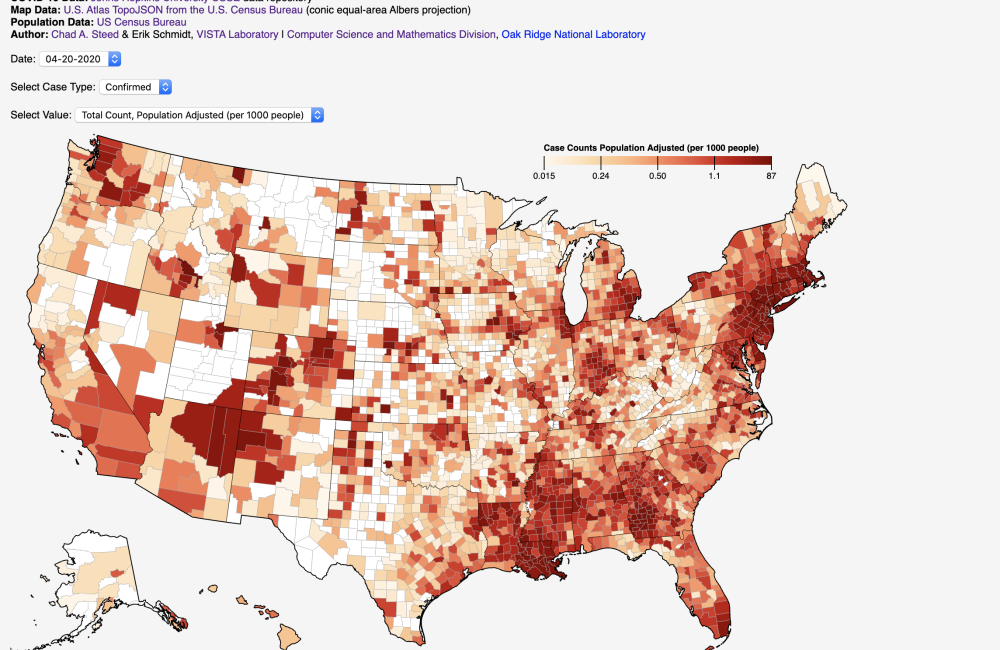VISTA researchers used data from Johns Hopkins to create this nationwide choropleth map of cases at the county level.
- Visualization
- Supercomputing
It's no secret that scientific datasets are getting larger, and therefore more difficult to ingest, clean, and analyze.
These processes, collectively known as “data wrangling,” present major obstacles for researchers attempting to harness the power of big data to accelerate scientific breakthroughs.
Hence the need for advanced visualization, an increasingly valuable tool for researchers in developing a comprehensive understanding of their experiments and simulations and assisting them in communicating new findings effectively.
In recognition of this growing need, the Department of Energy’s Oak Ridge National Laboratory has launched the Visual Informatics for Science and Technology Advances (VISTA) laboratory, an experimental facility that will allow visualization and data specialists to harness new software and hardware technologies in their efforts to tackle challenges across the scientific spectrum. For instance, it has proven critical in evaluating algorithms, debugging, presenting results, and forming actionable plans for future experiments.
But it’s a specialty in its own right, and one largely outside the purview of domain scientists. With dozens of ORNL staff and postdocs who specialize in data visualization, VISTA will provide a hub for ORNL researchers seeking to transform data into dynamic visual representations that accurately convey the structure and connections of physical phenomena.
“Augmented reality, virtual reality, data visualizations, intelligent user interfaces, nothing is off limits,” said Chad Steed, VISTA director and senior staff researcher in ORNL’s Computer Science and Mathematics Division. Steed sees VISTA as ORNL’s epicenter for internal consulting, connecting researchers with the ideal visualization personnel and recommending products and resources to help them accomplish their visualization and data analysis goals.
Before joining ORNL in 2010, Steed spent nine years as a computer scientist with the Naval Research Laboratory. His research spans the life cycle of data science including interactive data visualization, visual analytics, human-computer interaction, visual perception, and database design. The applications of his research are broad, from climate science and materials science to additive manufacturing, healthcare, and national security.
”I like to think of VISTA as a testbed, mixing creative innovations with practical applications while increasing ORNL’s stature as a premiere data analytics laboratory,” he said. “Ultimately, we envision VISTA to operate similar to ORNL’s Manufacturing Demonstration Facility, in that it allows us to develop and evaluate new approaches and share the most promising tech to the scientific communities.”
The laboratory will provide an “approachable, user friendly environment,” he added, allowing visualization staff to set up and configure collaborative spaces for specific domains while serving as a mini-facility that facilitates the sharing of ideas, innovations, and best practices. In addition, scientists at the lab can come to VISTA to find specific expertise and general purpose tools that can be brought to bear on their biggest challenges.
In fact, Steed and Vista Data Visualization Engineer Erik Schmidt have already constructed visualizations using current COVID-19 data from Johns Hopkins University to represent recently reported statistics for confirmed cases and deaths at a county level of detail for the U.S. The map is interactive and the independent values can be interactively changed. At a glance, it provides a view of the hot spots for outbreaks, while another view provides a timeline view of historical data that is highly interactive and can be adjusted to show country statistics, states, and daily changes in values.
Efforts such as this show just how critical visualization is to a wide range of scientific domains, from epidemiology to disaster mitigation to urban planning. But VISTA will also assist larger visualization community in advancing their state of the art.
“There are sub-domains within visualization, such as scientific visualization, information visualization, and visual analytics, and having a centralized lab where the various experts can get together and discuss challenges is an enormous advantage,” said David Pugmire, a senior scientist in ORNL’s Scientific Data Group, who partners with Steed in defining and executing the mission of VISTA.
Pugmire’s VTK-m toolkit supports visualization and analysis of ORNL data on platforms like Summit, the laboratory’s flagship high-performance computing system and currently the world’s fastest, as well as Frontier, ORNL’s first exascale system that is set to come online in 2021. Specifically, VTK-m enables the fine-grained concurrency required to drive extreme-scale computing by providing abstract models for data and execution that can be applied to a variety of algorithms across many different processor architectures.
VISTA is also expected to greatly benefit the broad spectrum of artificial intelligence research taking place across the laboratory. “Visualization is integral to understanding data at the onset of a project and helps AI developers find the best match between data and AI techniques,” said Steed.
VISTA will complement the laboratory’s existing Exploratory Visualization Environment for Research in Science and Technology (EVEREST) facility, which provides analysis and visualization of simulation data generated by the Oak Ridge Leadership Computing Facility’s supercomputers.
VISTA will also serve as the proving ground for technologies that might one day be pushed out to EVEREST, said Steed, adding that there are also plans to connect VISTA with ORNL’s Compute and Data Environment for Science (CADES) resource and other OLCF resources.
CADES serves as a foundational “big data center” that aspires to address present and future DOE data challenges. The platform enables user facilities, staff members, and research teams to process, manage, and analyze large amounts of data by leveraging high-performance computing resources, scalable storage, data analysis, and cloud tools.
For more information on VISTA visit vis.ornl.gov. The VISTA lab was established with internal funding.
ORNL is managed by UT-Battelle for the U.S. Department of Energy's Office of Science, the single largest supporter of basic research in the physical sciences in the United States. DOE’s Office of Science is working to address some of the most pressing challenges of our time. For more information, please visit https://energy.gov/science.






